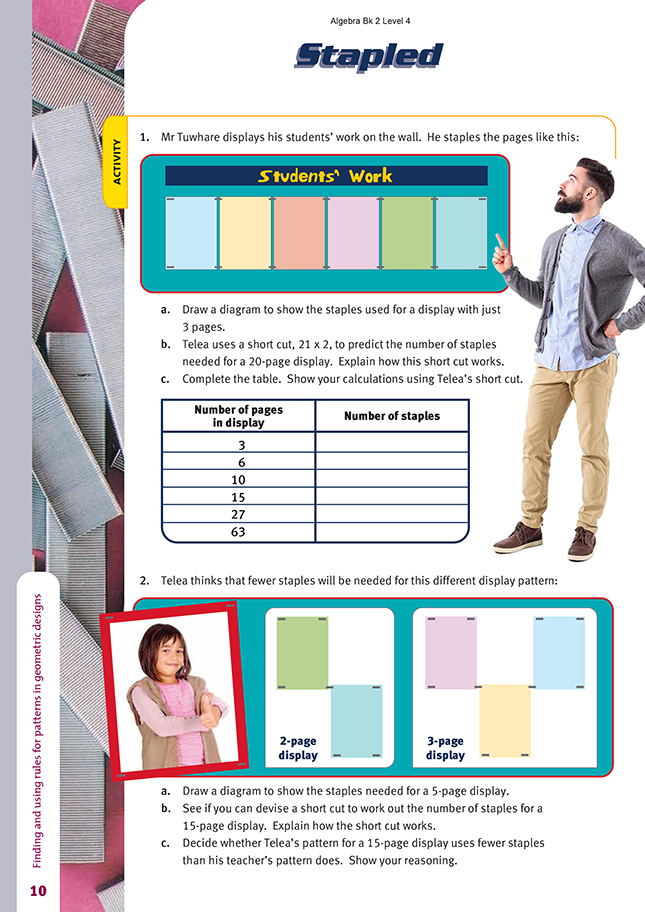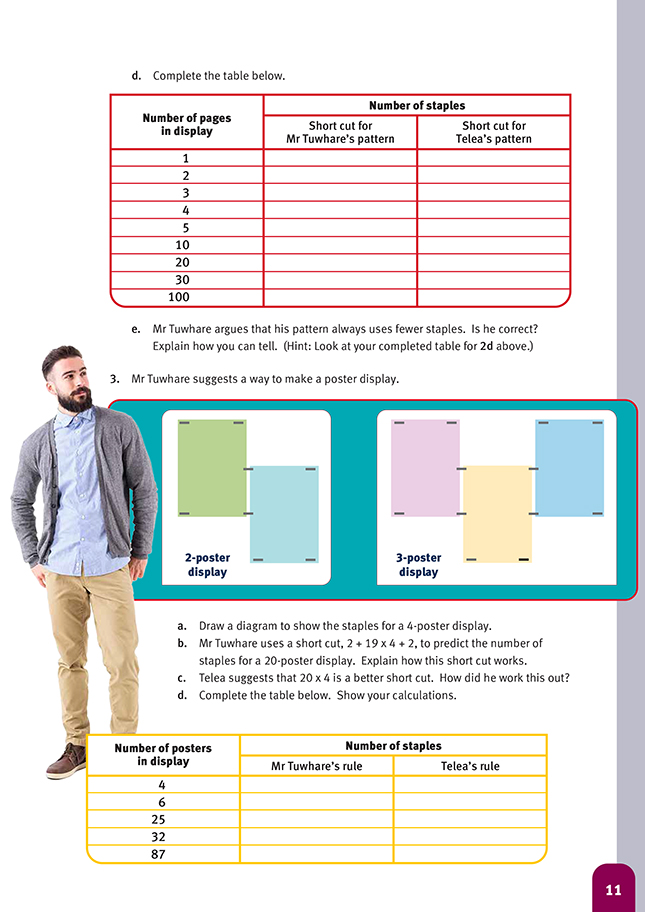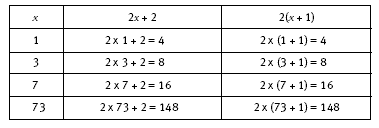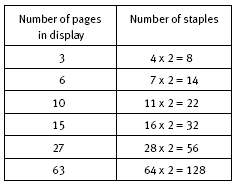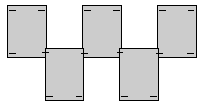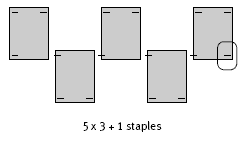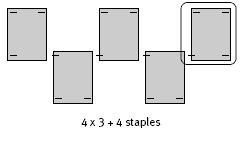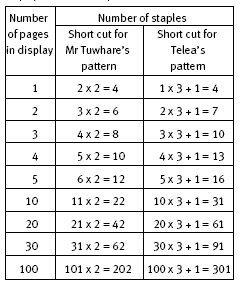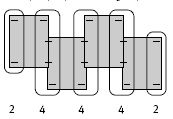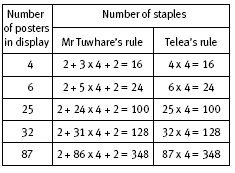This is a level 4 algebra strand activity from the Figure It Out series.
Click on the image to enlarge it. Click again to close. Download PDF (296 KB)
use a table to continue a pattern
use an equation to describe the relationship
FIO, Level 4, Algebra, Book Two, Stapled, pages 10-11
This activity asks students to explore different arrangements for stapling pages and posters for a wall display.
The students could set up similar displays on their classroom walls. They should also draw each display, including the staples, to help them visualise how each short cut and associated rule works.
In question 1, notice how the stapling works for a 3-page display:
Each page has 2 staples, and the last page has an additional 2 staples. So a display with 30 pages has 30 x 2 + 2 staples. This is the same as 30 x 2 + 1 x 2 or 31 x 2. This means that a 100-page display has 101 x 2 = 202 staples. Using algebraic symbols, a display with x pages will have x x 2 + 2 or (x + 1) x 2
staples, or more simply, 2(x + 1) or 2x + 2. Not everyone is easily convinced that 2x + 2 and 2(x + 1) are equivalent, but completing a table like the one below usually helps.
As indicated earlier, it is not generally intended for students at this level to work with algebraic rules expressed in symbolic form, but some students may benefit from doing so.
So, for a 100-page display, the number of staples is 100 x 3 + 1 or 99 x 3 + 4. The value for each short cut is 301. These short cuts give rise to the algebraic rules x x 3 + 1 and (x – 1) x 3 + 4 for x pages. The rules are written as 3x + 1 and 3(x – 1) + 4 respectively. The two short cuts are easily shown to be equivalent
algebraically: 3 x (x – 1) + 4 = 3(x – 1) + 4 or 3x – 3 + 4, which is 3x + 1, although doubters may need to complete a table similar to the one shown for question 1.
In questions 2d–e, the students compare the display from question 1 (Mr Tuwhare’s) with Telea’s in 2a to see which uses fewer staples. They should find that for the completed data in the table, Mr Tuwhare’s pattern uses fewer staples when there is more than 1 page in the display. This claim can be extended to all displays with
more than 1 page by first noticing that the number of staples increases by 2 for each page added to Mr Tuwhare’s display and increases by 3 for each page added to Telea’s display. So the number of staples in Telea’s display increases at a faster rate than it does for Mr Tuwhare’s display.
In question 3, this 4-poster display has 2 + 3 x 4 + 2 or 3 x 4 + 4 staples. The short cut 3 x 4 + 4 is the same as 4 x 4. A 10-poster display will have 9 x 4 + 4 staples or 10 x 4 staples, and a 100-poster display will have 99 x 4 + 4 or 100 x 4 staples. A display with x posters will therefore have 4(x – 1) + 4 or 4x staples. (Mathematical
Answers to Activity
1. a.
b. In the diagram for 3 pages below, each page has 2 staples. An additional 2 staples are used for the final page. So 3 pages need 3 x 2 + 2 or 4 x 2 staples. A 20-page display will need 20 x 2 + 2 or 21 x 2 = 42 staples.
c.
2. a.
b. Two possible short cuts are 15 x 3 + 1 = 46 staples and 14 x 3 + 4 = 46 staples. For a 5-page display, these are:
For the short cut 5 x 3 + 1, each of the 5 pages has 3 staples, which is 5 x 3 staples altogether. One more staple is then needed, so the 5-page display needs a total of 5 x 3 + 1 staples. So a 15-page display will need 15 x 3 + 1 = 46 staples.
For the short cut 4 x 3 + 4, each of the first 4 pages has 3 staples, which is 4 x 3 staples altogether. The last page has 4 staples, so the 5-page display needs a total of 4 x 3 + 4 staples. So a 15-page display will need 14 x 3 + 4 = 46 staples.
c. A 15-page display using Mr Tuwhare’s pattern has 16 x 2 = 32 staples. Telea’s pattern has 46 staples for 15 pages. So Telea’s pattern for a 15-page display uses more staples than Mr Tuwhare’s.
d.
e. Mr Tuwhare is not entirely correct. When there is just a 1-page display, he and Telea use the same number of staples, that is, 4. However, the number of staples used for Mr Tuwhare’s pattern increases by 2 for each page added, while for Telea’s pattern, the number of staples used increases by 3 for each page added. So,
for displays with 2 or more pages, Mr Tuwhare’s pattern will always use fewer staples.
3. a.
b. The 4-poster display has
2 + 4 + 4 + 4 + 2 = 2 + 3 x 4 + 2 staples.
A 6-poster display will have 2 + 5 x 4 + 2 staples. So a 20-poster display will have 2 + 19 x 4 + 2 staples.
c. The short cut 2 + 19 x 4 + 2 is the same as 19 x 4 + 4. This is equivalent to 19 sets of 4 plus 1 set of 4, or 20 sets of 4. As a short cut, 20 x 4 = 80 is much simpler than 2 + 19 x 4 + 2 = 80.
d.
